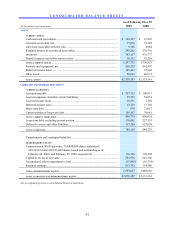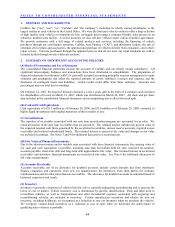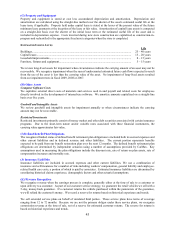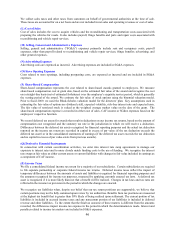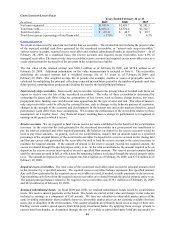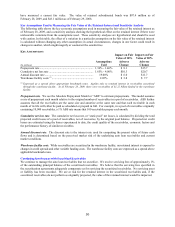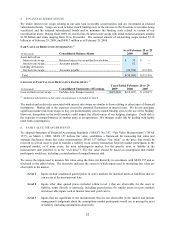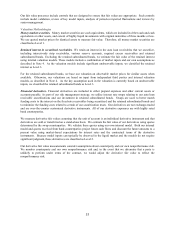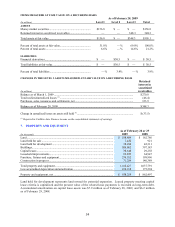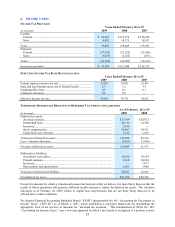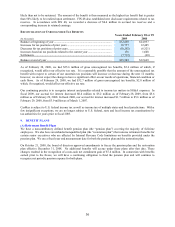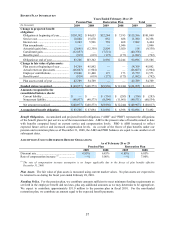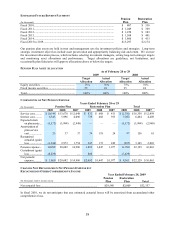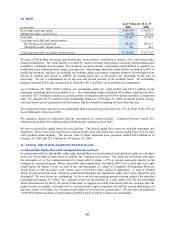CarMax 2009 Annual Report Download - page 57
Download and view the complete annual report
Please find page 57 of the 2009 CarMax annual report below. You can navigate through the pages in the report by either clicking on the pages listed below, or by using the keyword search tool below to find specific information within the annual report.
51
PAST DUE ACCOUNT INFORMATION
As of February 28 or 29
(In millions) 2009 2008 2007
Accounts 31+ days past due....................................................... $ 118.1 $ 86.1 $ 56.9
Ending managed receivables...................................................... $ 3,986.7 $ 3,838.5 $ 3,311.0
Past due accounts as a percentage of ending managed
receivables.............................................................................. 2.96% 2.24% 1.72%
CREDIT LOSS INFORMATION
Years Ended February 28 or 29
(In millions) 2009 2008 2007
Net credit losses on managed receivables.................................. $ 69.8 $ 38.3 $ 20.7
Average managed receivables ................................................... $4,021.0 $3,608.4 $ 3,071.1
Net credit losses as a percentage of average managed
receivables.............................................................................. 1.74% 1.06% 0.67%
Recovery rate............................................................................. 44% 50% 51%
SELECTED CASH FLOWS FROM SECURITIZED RECEIVABLES
Years Ended February 28 or 29
(In millions) 2009 2008 2007
Proceeds from new securitizations ............................................ $1,622.8 $2,040.2 $1,867.5
Proceeds from collections ......................................................... $ 840.6 $1,095.0 $1,011.8
Servicing fees received.............................................................. $ 41.3 $ 37.0 $ 32.0
Other cash flows received from the retained interest:
Interest-only strip receivables ................................................ $ 96.7 $ 98.6 $ 88.4
Reserve account releases........................................................ $ 6.4 $ 9.4 $ 15.2
Proceeds from new securitizations. Proceeds from new securitizations include proceeds from receivables that are
newly securitized in or refinanced through the warehouse facility during the indicated period. Balances previously
outstanding in term securitizations that were refinanced through the warehouse facility totaled $101.0 million in
fiscal 2009, $103.6 million in fiscal 2008 and $82.5 million in fiscal 2007. Proceeds received when we refinance
receivables from the warehouse facility are excluded from this table as they are not considered new securitizations.
Proceeds from collections. Proceeds from collections represent principal amounts collected on receivables
securitized through the warehouse facility that are used to fund new originations.
Servicing fees received. Servicing fees received represent cash fees paid to us to service the securitized receivables.
Other cash flows received from the retained interest. Other cash flows received from the retained interest
represents cash that we receive from the securitized receivables other than servicing fees. It includes cash collected
on interest-only strip receivables and amounts released to us from reserve accounts.
Financial Covenants and Performance Triggers
The securitization agreement related to the warehouse facility includes various financial covenants and performance
triggers. The financial covenants include a maximum total liabilities to tangible net worth ratio and a minimum
fixed charge coverage ratio. Performance triggers require that the pool of securitized receivables in the warehouse
facility achieve specified thresholds related to portfolio yield, loss rate and delinquency rate. If these financial
covenants and/or thresholds are not met, we could be unable to continue to securitize receivables through the
warehouse facility. In addition, the warehouse facility investors could have us replaced as servicer and charge us a
higher rate of interest. Further, we could be forced to deposit collections on the securitized receivables with the
warehouse agent on a daily basis, deliver executed lockbox agreements to the warehouse facility agent and obtain a
replacement counterparty for the interest rate cap agreement related to the warehouse facility. As of February 28,
2009, we were in compliance with the financial covenants and the securitized receivables were in compliance with
the performance triggers.


